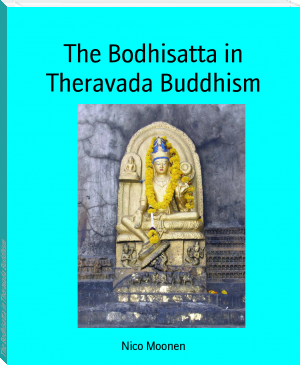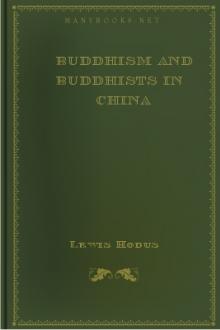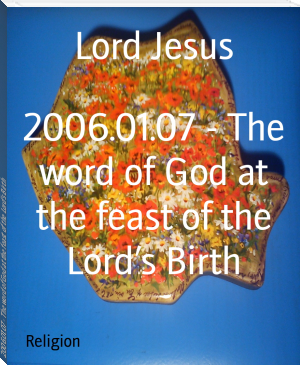The Bodhisatta in Theravada Buddhism by Nico Moonen (best books to read now .TXT) 📖

- Author: Nico Moonen
Book online «The Bodhisatta in Theravada Buddhism by Nico Moonen (best books to read now .TXT) 📖». Author Nico Moonen
[106] Narada 1980, p. 573-574.
[107] Ghatikara Sutta, M.IX,81, in: Neumann 1956, p. 601-608; Horner 1975a, p. 90 (XXV.10-15).
[108] Points of Controversy, p. 167-170 (IV.8).
[109] Ledi 2000, p. 25.
[110] Ledi 1899, p. 29-33; Ledi 2000, p. 22-25.
[111] Horner 1991, p. 109-117 (VIII.2).
[112] Narada 1980, p. 594.
[113] Horner 1975a, p. 9-93.
[114] Horner 1975a, p. 14, 17, 25 (II A. 52-53, 80-81, 188); Horner 1978, p. 130, 170.
[115] Horner 1975a, p.31 (III.22-24) and p. 34 (IV.16-17).
[116] Horner 1975a, p. 33, 34 (IV.10-11, 15-16); Horner 1978, p. 218.
[117] Does this mean that the nāga-king stripped off his old hide? If so, can it be considered as a great deed?
[118] Horner 1975a, p. 37 (V.16-17).
[119] Horner 1975a, p. 39 (VI.10-11).
[120] Horner 1975a, p. 42 (VII.12).
[121] Horner 1975a, p. 44 (VIII.12-13).
[122] Horner 1975a, p. 47 (IX.10-11).
[123] Horner 1978, p. 260.
[124] Himavant = highest mountain of the Himālaya.
[125] Horner 1975a, p. 50 (X.13-14); Horner 1978, p. 270.
[126] Horner 1975a, p. 53 (XI.11-12).
[127] Horner 1975a, p. 55-56 (XII.11-12).
[128] Horner 1975a, p. 58-59 (XIII.11-14, 18); Horner 1978, p. 296.
[129] Horner 1975a, p. 61 (XIV.9-11).
[130] Horner 1975a, p. 63-64 (XV.9-10).
[131] Horner 1975a, p. 66 (XVI.9); Horner 1978, p. 318.
[132] Horner 1975a, p. 68 (XVIII.8-9); Horner 1978, p. 323.
[133] Horner 1975a, p. 70 (XVIII.9-12); Horner 1978, p. 329.
[134] Horner 1975a, p. 73 (XIX.8, 12-13).
[135] Horner 1975a, p. 75 (XX.10-12); Horner 1978, p. 343.
[136] Horner 1975a, p. 78 (XXI.9-11).
[137] Horner 1975a, p. 81 (XXII.11-15); Horner 1978, p. 356.
[138] Horner 1975a, p. 84 (XXIII.8-9, 13); Horner 1978, p. 364.
[139] Horner 1975a, p. 87 (XXIV.9-11, 15).
[140] Horner 1975a, p. 90 (XXV.10-15, 32).
[141] Horner 1975 ab, p. x.
[142] Horner 1978, p. 3-6.
[143] Winternitz, M.: Geschichte der Indischen Litteratur. Zweiter Band. Erste Hälfte. Die buddhistische Litteratur, Leipzich 1913, p. 129-131; Horner 1975a, p. xiii; Rhys Davids, T.W.: Buddhist India, (repr.) Delhi 1987, p. 176-177.
[144] Horner 1975a, p. xlvii.
[145] Horner 1990), p. xxxv.
[146] Wimalaratana, Bellanwilla: Concept of Great Man (Mahāpurisa) in Buddhist Literature and Iconography, Singapore [s.a.], p. 1, 7, 20-25.
[147] Points of Controversy, p.166-167 (IV.7); see also: D.3 and D.30, in: Walshe 1996, p. 112 and p. 441.
[148] See also: Piyadassi Thera: The Buddha. A Short Study of His Life and Teaching, (3rd enlarged ed.) Kandy 1970, The Wheel No. 5ab, p. 3.
[149] See: D.30:1.2 , in: Walshe 1996, p. 441-442; and in: Neumann, Karl Eugen (Übers.): Die Reden Gotamo Buddhos. Aus der längeren Sammlung Dīghanikāyo des Pāli-Kanons, (3. Aufl.) Zürich 1957, p. 516-539. See also: M.X.91, Brahmāyu, in: Neumann 1956, p. 692-693. – For comparative translations in several Mahāyāna-works, see: Burnouf, M.E. (tr.): Le lotus de la bonne loi, Paris 1973, p. 553-583.
[150] Normally one has 32 teeth. Even in very ancient skeletons archaeologists have not found more than 32 teeth. – According to Neumann 1956, p. 1115 note 248 the meaning of it is that the number of his teeth is between 30 and 40.
[151] Wimalaratana, p. 13-14.
[152] Translation of these stanzas in: Norman, K.R. (tr.): The group of Discourses (Sutta-Nipāta), Vol. I, with alternative translations by I.B. Horner and Walpola Rahula, London 1984, V.3; and in: Nyānaponika (Übers.): Sutta-Nipāta : Früh-buddhistische Lehr-Dichtungen aus dem Pali-Kanon. Mit Auszügen aus den alten Kommentaren, (2. revid. Aufl.) Konstanz 1977, V.3.
[153] Wimalaratana, p. 15; translation of these stanzas in: Nārada Thera (tr.): The Dhammapada: Pali Text and translation with stories in brief and notes, (3rd ed.) Colombo 2522-1978 (1st ed. 1963) stanza 352.
[154] D.30, in Walshe 1996, p. 441-460.
[155] M.135, ‘Cūla-Kammavibhanga Sutta’, in: Ñanamoli Thera (tr.): The Buddha's Words on Kamma. Four Discourses of the Buddha from the Middle Length Collection, edited by Khantipālo Bhikkhu, Kandy 1977, The Wheel No. 248/249, p. 13-21. Also in: Neumann 1956, p. 991-996.
[156] see D.30, in: Walshe 1996, p. 441-460.
[157] Horner 1975a, p. 20-23.
[158] Nārada 1980, p. 576.
[159] Buddharakkhita, Acharya: Nature of Buddha's Enlightenment. Bangalore 1986, p. 14-15.
[160] Ledi 1899, p. 9-10; Ledi 2000, p. 8-9. See also: Buddharakkhita 1986, p. 15.
[161] Buddharakkhita 1986, p. 15-16.
[162] About the giving of one’s life or limbs, see chapter 6.
[163] Buddharakkhita 1986, p. 15-16.
[164] It is dangerous to claim that only after fulfilling the basic perfections one can become an Arahant. Many a man might think: “We cannot attain the high goal.” And then he or she puts one’s trust in the power of others instead of in own power.
[165] Ledi (1899) p.17-18 ; Ledi (2000) p. 14-15.
[166] Horner 1975b, p. iv, vi, vii.
[167] Wimalaratana p. 7, 13, 25 and 180-182.
[168] Bodhi 1978, p. 259.
[169] Nārada 1980, p. 608.
[170] This law regulates the future birth. Only Buddhas and Arahants are not reborn again. They don’t “produce” kamma anymore.
[171] Nārada 1980, p. 608-609.
[172] See: Horner 1978, p. 388.
[173] Points of Controversy, p. 366 (XXIII.3).
[174] Gnanarama, Ven. Pategama: The Mission Accomplished : A historical analysis of the Mahaparinibbana Sutta of the Digha Nikaya of the Pali Canon. Singapore 1997, p. 77-79.
[175] Upatissa, Arahant: The Path of Freedom (Vimuttimagga). Transl. into Chinese by Tipitaka Sanghapāla of Funan; transl. from the Chinese by Rev. N.R.M.Ehara, Soma Thera & Kheminda Thera. (repr.). Kandy 1995, p. 190.
[176] Speyer, J.S. (tr.): The Jātakamālā or Garland of Birth-Stories of Āryasūra, (repr.) Delhi 1982, p. xi.
[177] Dutoit, Julius (übers.): Jātakam. Das Buch der Erzählungen aus früheren Existenzen Buddhas, Leipzich 1908, Bd. I, p. III.
[178] Pim-Aksorn, Phramaha Tuan: Buddhist Concept of Karunā and World Peace, Varanasi 1988, p. 117.
[179] Donath, Dorothy C.: Buddhism for the West – Theravāda, Mahāyāna and Vajrayāna, New York 1971, p. 43.
[180] See: Pantschatantra. Fünf Bücher altindischer Staatsweisheit und Lebenskunst in Fabeln und Sprüchen, Hrsg. u. übers. von Ludwig Alsdorf, Bergen II 1952; or: Pantschatantra. Die fünf Bücher der Weisheit, Aus dem Sanskrit übertragen von Theodor Benfey (1859), bearbeitet von Karin Fitzenreiter, Berlin 1978.
[181] Kern, H.: Geschiedenis van het Buddhisme in Indië, Haarlem 1882, Vol. 1, p. 256-257.
[182] Speyer 1982 (1895), p. xxii.
[183] Winternitz, M.: Geschichte der Indischen Litteratur. Zweiter Band. Erste Hälfte . Die buddhistische Litteratur, Leipzich 1913, p. 89-134.
[184] Winternitz 1913, p. 89-90. See also: Rhys Davids, T.W.: Buddhist India, (reprint) Delhi 1987, p.165.
[185] Winternitz 1913, p. 91.
[186] Winternitz 1913, p. 91-92; Rhys Davids 1987, p. 194-195.
[187] Glasenapp, Helmuth von: Die Literaturen Indiens von ihren Anfängen bis zur Gegenwart, Wildpark-Potsdam 1929, p. 134-137; Rhys Davids 1987, p. 196.
[188] Rhys Davids 1987, p. 196.
[189] Rhys Davids 1987, passim.
[190] Saddhatissa, H.: The Birth-stories of the Ten Bodhisattas and the Dasabodhisattuppattikathā, being a Translation and Edition of the Dasabodhisattuppattikathā, London 1975, p. 5-6; and: Winternitz 1913, p. 92-93.
[191] Rhys Davids 1987, p. 196-197.
[192] Winternitz 1913, p. 97.
[193] Winternitz 1913, p. 94-95.
[194] Rhys Davids 1987, p. 189-208.
[195] Winternitz 1913, p. 99-100.
[196] idem.
[197] Winternitz 1913, p. 96.
[198] Quoted in: Rhys Davids 1987, p. 202.
[199] Rhys Davids 1987, p. 202.
[200] Rhys Davids 1987, p. 207
[201] Sen, Benoychandra: Studies in the Buddhist Jātakas (tradition and polity), Calcutta 1974, p. I.
[202] idem, p. II.
[203] idem, p. III.
[204] idem, p.54-60.
[205] See: Ling, Trevor: A Dictionary of Buddhism. Indian and South-East Asian, Calcutta/New Delhi 1981 (see: Jātaka); and: Nārada Thera (tr.): The Dhammapada : Pali Text and translation with stories in brief and notes, (3rd ed.) Colombo 2522-1978, p. viii. See also: Dutoit 1908, Bd. I, p. IV; and: Kern 1882, dl. 1, p. 257; and: Dutoit, Julius (übers.): Das Leben des Buddha. Eine Zusammenstellung alter Berichte aus den kanonischen Schriften der südlichen Buddhisten, Leipzich 1906, p. XVIII-XIX.
[206] See: Gombrich, Richard F.: How Buddhism Began : The Conditioned Genesis of the Early Teachings, London 1996, p. 65-67.
[207] Speyer 1982, p. xiii.
[208] Speyer 1982, p. xiii.
[209] Seewali Thero, Ven. Rassagala: A Critical Study of Ethical Problems of Bodhisatta's Karunā in Jātaka Stories, Bangkok 2542/1999.
[210] S. II, 267, cited by Phra Khantipalo, in: The Splendour of Enlightenment, Bangkok 1987, Vol.II, p. 392-393.
[211] ‘Account of Sumedha’, in: Horner, I.B. (tr.): Chronicle of Buddhas (Buddhavamsa). London 1975 [a], p. 9-25.
[212] The ten Pāramīs are mentioned in: Horner 1975a, p. 20-23; see also: Bodhi, Bhikkhu (tr.): The Discourse on the All-Embracing Net of Views : The Brahmajāla Sutta and its Commentaries. Kandy 1978, p. 46.
[213] See: Kashyap, Bhikkhu J. (Gen. Ed.): The Apadāna (II) - Buddhavamsa - Cariyāpitaka (Khuddhakanikāya, Vol. VII). [s.l.] 1959, p. v; Winternitz,Maurice: A history of Indian Literature. Vol. II : Buddhist Literature and Jaina Literature. A new authoritative English translation by V. Srinivasa Sarma. (revised ed.). Delhi 1983, p. 155-156; Thomas, Edward J.: The Life of Buddha as Legend and History. (repr.) New Delhi 1992, p. 275; Grönbold, Günter: 'Die Mythologie des indischen Buddhismus,' in: Wörterbuch der Mythologie, Bd. 5. Stuttgart 1984, p. 384; Bareau, André: “Der indische Buddhismus,” in: Die Religionen Indiens, III, Stuttgart 1964, p.26-27; Norman, K.R.: Pāli Literature, including the Canonical Literature in Prakrit and Sanskrit of all the Hînayāna Schools of Buddhism. Wiesbaden 1983, p. 92-94.
[214] Horner, I.B. (tr.): Basket of Conduct (Cariyāpitaka). London 1975 [b].
[215] See: Winternitz (II) 1983, p. 156-157; Thomas 1992, p. 275; Kashyap 1959, p. v.
[216] Bodhi, Bhikkhu (tr.): 'A Treatise on the Pāramīs,' in: The Discourse on the All-Embracing Net of Views, Kandy 1978[a], p. 254-330.
[217] Bodhi, Bhikkhu (tr.): The Discourse on the All-Embracing Net of Views : The Brahmajāla Sutta and its Commentaries. Kandy 1978, p. 46-49.
[218] Upatissa, Arahant: The Path of Freedom (Vimuttimagga). Transl. into Chinese by Tipitaka Sanghapāla of Funan; transl. from the Chinese by Rev. N.R.M. Ehara, Soma Thera & Kheminda Thera. (repr.) Kandy 1995, p. 188-190.
[219] Buddhaghosa, Bhadantācariya: The Path of Purification (Visuddhimagga). Transl. by Bhikkhu Ñanamoli. Singapore [1956], p. 13-14, 216, 352-353; Nyanatiloka (übers.): Visuddhi-Magga oder Der Weg zur Reinheit. Die grösste und älteste systematische Darstellung des Buddhismus, (3. Aufl.) Konstanz 1975, p. 371.
[220] Ledi Sayādaw, Ven.: A Manual of the Excellent Man, Uttamapurisa Dīpanī. Transl. from the Burmese by U Tin Oo; edited by Bhikkhu Pesala. Kandy 2000.
[221] Nārada Maha Thera: ‘Pārami – Perfections,’ in: The Buddha and His Teachings. Kandy 1980, p. 576-611.
[222] D.30 : ‘Lakkhaņa Sutta : The Marks of a Great Man’, in: Walshe, Maurice (tr.): The Long Discourses of the Buddha, Kandy 1996, p. 441-460.
[223] Bodhi 1978a, p. 259.
[224] Ledi 2000, p. 2; Bodhi 1978a, p. 260.
[225] Upatissa 1995, p.188.
[226] Buddhaghosa 1956, p. 352-353.
[227] D.30:1.4, in: Walshe 1996, p. 442.
[228] D.30:1.16/18, in: Walshe 1996, p.446-447.
[229] D.30:1.13/15, in: Walshe 1996, p.446.
[230] D.30:2.13/15, in: Walshe 1996, p. 455.
[231] D.30:1.28/30, in: Walshe 1996, p. 450.
[232] D.30:1.31/33, in: Walshe 1996, p. 451.
[233] D.30:2.4, in: Walshe 1996, p. 452.
[234] D.30:1.7/8, en 2.13, in: Walshe 1996, p.444-445.
[235] D.30:2.19/21, in: Walshe 1996, p.456-457.
[236] Bodhi 1978a, p. 289, 291.
[237] Horner 1975a, p. 20 (II A:120); Horner, I.B. (tr.): The Clarifier of the Sweet Meaning (Madhuratthavilāsinī). Commentary on the Chronicle of Buddhas (Buddhavamsa) by Buddhadatta Thera. London 1978, p. 89 and 152.
[238] See: Nārada Maha Thera: The Buddha and His Teachings. (4th enlarged ed.) Kandy 2524/1980, p. 578.
[239] Horner, I.B. (tr.): Milinda's Questions. Vol. II. Oxford 1991, p. 95-109.
[240] Bodhi 1978a, p. 259/260.
[241] Ledi 2000, p. 2-3; Bodhi 1978a, p. 260.
[242] D.30:1.4/6, in: Walshe 1996, p.442-443. – This is also the way leading to wealth and high birth. (M.135).
[243] D.30:1.7/8, en 2.13, in: Walshe 1996, p.444-445.
[244] D.30:1.10/12, and D.30:2.7/9, in: Walshe 1996, p.445-446 and p.453-454; Buddhaghosa 1956, p. 353. – Not harming others leads to health and not killing leads to long life. (M.135).
[245] D.30:1.16/18, in: Walshe 1996, p.446-447.
[246] D.30:1.19/21, in: Walshe 1996, p.447-448.
[247] D.30:2.13/15, in: Walshe 1996, p.455.
[248] D.30:2.22/24, in: Walshe 1996, p.457.
[249] D.30:2.28/30, in: Walshe 1996, p.458-459.
[250] Bodhi 1978a, p. 296
[251] Horner 1975a, p. 20 (II A: 125), note 4; Horner 1978, p. 153/154.
[252] Bodhi 1978a, p. 260-261, 303-304; Ledi 2000, p. 3, 10; Horner 1975a, p. 20 (II A: 129-130); Horner 1978, p. 153-154; Nārada 1980, p. 592-593; Upatissa 1995, p. 188-190.
[253] Buddhaghosa 1956, p. 353.
[254] Bodhi 1978a, p. 260.
[255] Ledi (1899) p. 3; Ledi 2000, p. 3; Bodhi 1978a, p.261.
[256] Bodhi 1978a,





Comments (0)